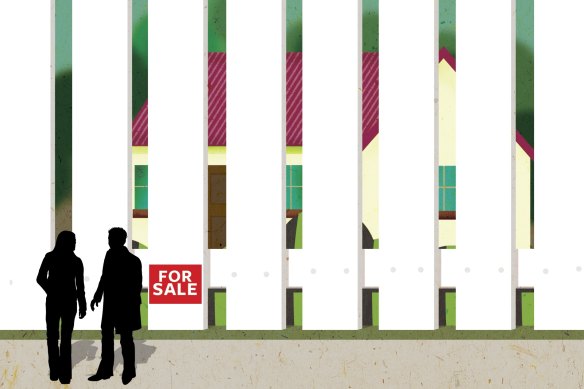
Of course, if there’s anything wrong with the way the world’s run, it wasn’t anything I did, it was those terrible pollies. Yeah, nah.
Since older home owners have always far out-numbered the young would-be home owners, the politicians have always run the housing game to favour those who love seeing property prices rise – and, now you mention it, wouldn’t mind buying another house as an investment.

The young have been systematically locked out of the housing market by tax and financial arrangements which favour older Australians. Credit:Simon Bosch
At present, it’s easy to conclude the big problem with housing affordability is rising interest rates and so blame it all on the Reserve Bank boss Dr Philip Lowe. But, as I’ve written elsewhere, although it’s reasonable to ask whether putting interest rates up and down is a sensible and fair way to manage the economy, that’s a separate issue.
Home loans take two to tango: how much you have to borrow and the interest rate on the loan. The interest rate cycles up and down around a relatively stable average, whereas the amount you need to borrow has gone up and up, decade after decade.
True, house prices are falling at present, but this is just returning them to where they were before they took off during the pandemic. It’s a safe bet that, once they’ve finished falling, they’ll resume their upward climb.
Loading
This is why oldies are wrong to scoff at young people complaining about mortgage interest rates of 5 per cent. “In my day, I had to pay 17 per cent!” Yes, you did – for a year or so in the early 1990s, when the amount you had to borrow was much less.
What’s true is that, right now, it’s mainly younger people who borrowed huge sums in the past few years who’re really feeling the pain.
But the real question is why house prices have risen so far for so long. They’ve risen much faster than incomes. The Grattan Institute calculates that whereas typical house prices used to be about four times incomes, now they’re more than eight times – and even more in Melbourne and Sydney.
But why? Not because of anything the Reserve Bank has done. Nor so much because we’ve failed to build enough additional houses and units to accommodate the growth in the population.
More because our tax and social security rules have made home ownership a highly attractive, government-favoured form of investment, not just a place you can call your own and not be chucked out of as long you keep up the payments. People who buy investment properties out-compete would-be first home owners, bidding up the price.
But also because there’s more competition to buy homes in particularly desirable areas. Spots near the beach or the river, for instance, but also places near where the jobs are.
People have been crowding into the big cities, trying to get close to the CBD with all its well-paid office jobs, but the older home owners fight hard to discourage governments from making room for younger newcomers. “It’s so ugly.”
And the bank of mum and dad (yes, I’ve done it) is helping prices stay high, while widening the divide between those young people with well-placed parents and those without.









 Add Category
Add Category